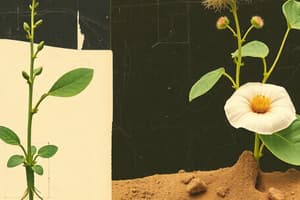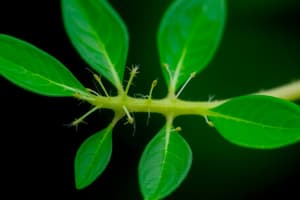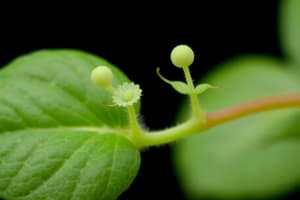Podcast
Questions and Answers
Which process primarily contributes to a plant's increase in stem diameter?
Which process primarily contributes to a plant's increase in stem diameter?
- Morphogenesis in the leaves
- Cell differentiation in the root tips
- Secondary growth, facilitated by lateral meristems (correct)
- Primary growth, driven by apical meristems
A plant's ability to form specialized cells from generalized ones is best described as:
A plant's ability to form specialized cells from generalized ones is best described as:
- Morphogenesis
- Primary growth
- Senescence
- Differentiation (correct)
Which of the following occurs during the seedling development stage of plant growth?
Which of the following occurs during the seedling development stage of plant growth?
- The plant absorbs water and breaks dormancy
- The plant reaches its maximum height
- The plant develops fully differentiated tissues and organs
- The plant establishes roots and shoots in the soil (correct)
Which of the following is an example of primary growth in plants?
Which of the following is an example of primary growth in plants?
What distinguishes development from growth in plants?
What distinguishes development from growth in plants?
How does seed germination initiate plant growth?
How does seed germination initiate plant growth?
Which meristem is responsible for the increase in plant height?
Which meristem is responsible for the increase in plant height?
Which stage of plant growth involves the plant reaching full maturity and developing reproductive structures?
Which stage of plant growth involves the plant reaching full maturity and developing reproductive structures?
What role do axillary or lateral buds play in plant growth?
What role do axillary or lateral buds play in plant growth?
In plant development, formation of complex tissues like xylem from undifferentiated cells is an example of:
In plant development, formation of complex tissues like xylem from undifferentiated cells is an example of:
Which of the following processes primarily contributes to the increase in a plant's length?
Which of the following processes primarily contributes to the increase in a plant's length?
Lateral meristems are primarily responsible for which type of plant growth?
Lateral meristems are primarily responsible for which type of plant growth?
During which phase of cell growth do cells typically increase in size by up to 10 times their original length?
During which phase of cell growth do cells typically increase in size by up to 10 times their original length?
What is the primary function of cells during the phase of differentiation (maturation)?
What is the primary function of cells during the phase of differentiation (maturation)?
Which of the following is considered a growth characteristic that can be measured to assess plant development?
Which of the following is considered a growth characteristic that can be measured to assess plant development?
Which developmental event marks the beginning of a plant's life cycle?
Which developmental event marks the beginning of a plant's life cycle?
A researcher is studying the effect of a new fertilizer on plant growth. Which measurement would provide the MOST direct indication of increased biomass?
A researcher is studying the effect of a new fertilizer on plant growth. Which measurement would provide the MOST direct indication of increased biomass?
A plant physiologist observes that a plant's root system is growing deeper into the soil. Which phase of cell growth is MOST directly contributing to this?
A plant physiologist observes that a plant's root system is growing deeper into the soil. Which phase of cell growth is MOST directly contributing to this?
If a plant's lateral meristem is damaged, which of the following is the MOST likely outcome?
If a plant's lateral meristem is damaged, which of the following is the MOST likely outcome?
A scientist is studying the effects of a growth hormone on plant development and wants to assess its impact during the maturation phase. Which characteristic should they focus on?
A scientist is studying the effects of a growth hormone on plant development and wants to assess its impact during the maturation phase. Which characteristic should they focus on?
Flashcards
Plant Growth
Plant Growth
Irreversible and permanent increase in the size of a plant, its parts, or a cell.
Plant Development
Plant Development
Qualitative structural changes throughout a plant's lifecycle, from germination to aging.
Morphogenesis
Morphogenesis
The acquisition of form and structure during plant development.
Cell Differentiation
Cell Differentiation
Signup and view all the flashcards
Primary Growth
Primary Growth
Signup and view all the flashcards
Secondary Growth
Secondary Growth
Signup and view all the flashcards
Seed Germination
Seed Germination
Signup and view all the flashcards
Seedling Development
Seedling Development
Signup and view all the flashcards
Adult Plant Formation
Adult Plant Formation
Signup and view all the flashcards
Lateral Bud Growth
Lateral Bud Growth
Signup and view all the flashcards
Meristems
Meristems
Signup and view all the flashcards
Apical Meristem
Apical Meristem
Signup and view all the flashcards
Lateral Meristem
Lateral Meristem
Signup and view all the flashcards
Phase of Division
Phase of Division
Signup and view all the flashcards
Phase of Elongation
Phase of Elongation
Signup and view all the flashcards
Phase of Differentiation
Phase of Differentiation
Signup and view all the flashcards
Growth Characteristics
Growth Characteristics
Signup and view all the flashcards
Development Characteristics
Development Characteristics
Signup and view all the flashcards
Study Notes
- Growth is an irreversible and permanent increase in the size of a plant, including parameters like cell size, tissue expansion, and overall mass.
- Development refers to a sequence of qualitative structural changes throughout a plant's lifecycle, from germination to aging (senescence).
- Morphogenesis is the acquisition of form and structure during development
- Differentiation is the transformation of generalized cells into specialized ones during development
Stages of Plant Growth
- Seed germination is the stage where the seed absorbs water, breaks dormancy, and starts metabolic activities.
- Seedling grows roots and shoots during seedling development, establishing itself in the soil.
- Adult plant formation occurs when the plant attains maturity with fully developed tissues, organs, and reproductive structures.
Meristems (Growing Regions)
- Apical meristems are located at the tips of roots and shoots
- Resposible for primary growth, increasing the plant's length
- Lateral meristems are found along the sides of stems and roots.
- Resposible for secondary growth, increasing the plant's girth
Phases of Cell Growth
- Phase of division (meristematic phase)
- This involves mitotic cell division in the meristematic zone
- Produces new cells for growth
- Phase of elongation
- Cells increase in size, up to 10 times their original length
- Root penetration happens deeper into the soil
- Contributes to size and length of plant tissues
- Phase of Differentiation (Maturation)
- Cells undergo specialization depending on their position in an organ
- Differentiated cells form complex tissues like vascular bundles and perform specific functions.
Primary vs. Secondary Growth
- Primary Growth:
- Occurs first and extends plant length above and below ground.
- Driven by apical meristems.
- Secondary Growth:
- Occurs after primary growth, increasing diameter and strength.
- Controlled by lateral meristems.
- Includes growth from axillary/lateral buds, contributing to plant branching.
Plant Growth and Development Characteristics
- Growth characteristics are measured by increases in fresh or dry weight, leaf area, and plant height.
- Development characteristics include a progression of chronological events such as germination, seedling emergence, leaf appear and senescence.
- Progression of chronological events includes:
- Leaf appearance
- Branching
- Flowering
- Fruiting
- Seedling
- Maturation
Factors Affecting Plant Growth
- Light, water, temperature, and nutrients are essential for plant growth but effect plant processes
- Light regulates the stomata and floral induction in plants
- Intensity and quality affect plant processes
- Duration influences leaf production and flowering.
- Water constitutes 90% of the plant body
- Necessary for cell elongation and expansion, photosynthesis, nutrient transport, and seed germination
- Absence causes stress and plant death
- Temperature is a key driver for metabolic processes like transpiration, photosynthesis, and flowering
- Optimal temperature accelerates growth
- Extremes (above or below optimum) slow down or halt development.
- Plants need macro and micro nutrients
- Deficiency in even one nutrient can lead to stunted growth and susceptibility to diseases
- Macronutrients are nitrogen, phosphorus, calcium
- Micro nutrients are iron, boron, manganese
Plant Growth Curve (Sigmoid Curve):
- Represents growth plotted against time
- Lag phase is the initial slow growth with seed germination, seedling emergence, and plant establishment
- Growth percentage is under 25%
- Log/Exponential Phase is the rapid growth phase with growth percentage from 25-70%
- Indicators are leaf production, branching and tillering
- Diminishing Phase is with slower growth and Growth percentage from 70-85%
- Indicators are flowering and seed production
- Stationary Phase is is when growth ceases and with growth 85-100%
- Indicators are ripening, maturity, and senescence
- Lag phase is the initial slow growth with seed germination, seedling emergence, and plant establishment
Plant Tissue Systems
- Dermal Tissue System:
- Forms the "skin" of the plant, for protection
- Predominantly has parenchyma cells.
- The epidermis is a single layer of tightly packed cells covering plant surfaces
- Functions in protection against water loss and pathogens
- Epidermis that is in plants undergoing secondary growth is replaced by the periderm
- Secretes a waxy coating called the cuticle on leaves to minimize water loss.
- Periderm with plants that have secondary growth replace the epidermis
- Cork cambium (meristematic) produces cork (phellem) outward and phelloderm inward.
- Cork (phellem) is the protective layer, prevents water loss and provides insulation.
- Phelloderm is the inner layer supporting the cork cambium.
- Functions in protection against pathogens and excessive water loss ans Insulation for the plant body
- Ground Tissue System:
- Constitutes the majority of the plant body
- Functions in Photosynthesis, storage, and structural support.
- The main cell type is Parenchyma
- Are living cells at maturity, perform metabolic activities, photosynthesis, food storage, and regeneration, Wound healing and organ regeneration
- Main sub types
- Chlorenchyma contains chloroplasts for photosynthesis,
- Aerenchyma contains large air spaces for gas exchange
- Collenchyma tissue
- Are living cells with unevenly thickened walls providing flexible support to leaves and young stems
- With angular thickening in corners
- Lamellar thickening on opposite sides and Lacunar with Thickening with intercellular spaces.
- Sclerenchyma provides strength, and support to mature plant parts.
- Non-Living cells with thick, lignified secondary walls
- Fibers: Long, slender cells occurring in bundles
- Sclereids: Short, irregularly shaped cells present seed coats & nut shells
- Vascular Tissue System
- Specialized for the transport of water, nutrients, and food
- Has a secondary role in providing structural support
- Tissue called Xylem conducts water and dissolved minerals
- Principal cells: Tracheids and vessel elements
- Additional cells that are parenchyma and sclerenchyma.
- Tissue called Pholem transports food (mainly sucrose)
- Has Sieve tubes and companion cells
- Fibers and parenchyma.
Generalized Plants
- Protoplasm is is the living content of the cell, with a nucleus being the control center for cell functions.
- Cytoplasm is a gel-like matrix where organelles are suspended
- The cell wall surrounds the protoplasm and provides structural integrity to the plant made predominantly of cellulose
- A growing plant cell secretes a thin primary cell wall that stretches as the cell enlarges; additional layers called the secondary cell wall develop when growth ceases
Types of Permanent Tissue
- Ground tissue such as Parenchyma, Collenchyma, Sclerenchyma
- Tissue such as Xylem and Phloem tissues are also called vascular tissue
- Several tissue such as the internal: Resin/oil vessels, Laticifers and external Hydathodes, Digestive glands can also be called Secretory Tissue
Secretory Tissue
- Specialized cells that secrete substances like resins, oils, and mucilage
Internal Secretory Tissues
- Resin and oil vessels that has Ducts surrounded by epithelial cells secreting essential oils and resins through Lysigeny called (dissolving cells)
- Laticifers are Cells or series of cells containing latexTypes that are Latex vessels and Latex cells: Unbranched cells
External Secretory Tissues
- Hydathodes or Glands excrete water during guttation
- Digestive glands are found in insectivorous plants like Drosera, secreting mucilage & digestive enzymes
- Nectaries are structures secreting nectar to attract pollinators that can be found floral or vegetative parts.
Definition and Structure of the Rhizosphere
- Soil region surrounding a the a plant's root hair interactions happens between roots and microorganisms
- It consists of three zones, defined by their proximity to the root
- Endorhizosphere includes the cortex and endodermis, where microbes and ions occupy free spaces between cells.
- The medial zone adjacent to the root, including the epidermis and mucilage is called Rhizoplane
- Ectorhizosphere, the outermost zone extending into bulk soil
Roots Exudates & Mucilages
- Root exudates are a Broad term including mucilage and soluble compounds
- Mucilages: Polysaccharide-rich, viscoelastic gels with adhesive properties
- Functions include
- Attract beneficial microbes
- Act as bait for pathogens
- Bind and remove toxic metals
- Functions include
Rhizodeposits
- Substances that roots impart to the surrounding soil
- Loss of cap and border cells
- Loss of insoluble mucilage
- Loss of soluble root exudates
- Loss of volatile organic carbon
- Loss of carbon to symbionts
- Loss of carbon due to death and lysis of root epidermal and cortical cells
Chemical Contributions of the Rhizosphere
- Occurs through Root carbon release amount
- Forms of carbon released can be organic or inorganic
- Organic (e.g., organic acids) vs inorganic (e.g., bicarbonate, HCO3-)
- Forms of carbon released can be organic or inorganic
- The organic forms influence chemical, physical, and biological processes in the rhizosphere through climatic and soil conditions
Root Hairs
- Functions include absoring water and nutrients and dying after about 3 weeks, creating a compost-like environment that contribute to microbial attraction and nutrient cycling
Microbe-Plant Relationships in the Rhizosphere
- Root carbon release influences the mircobe levels higher compared to bulk soil, leading to microbial competition
Key Micobial relationship
- Rhizobia bacteria converts atmospheric nitrogen to nitrate usable by the plants by residing in root nodules
- Symbiotic association between soil fungi and roots
- Ectomycorrhiza forms dense hyphae in intercellular spaces (Hartig net) while Endomycorrhiza are more common in penetrating hyphae through cell walls
- Promotion of rhizobacteria happens by Colonizing roots to enhance growth
- Example using Bacillus subtilis in forming biofilms on root surfaces
Why do crops vital for the future?
- Some of the world relies solely on Dominance of few crops
- These crops must feed over 7 billion people
- Supply Chain Vulnerability
- Current crops rely on long-distance transportation to markets by raising concerns about diverse global populations; but mainly Climate Challenges
Factors of Sustainable practices
- Utilize crops in sustainable approaches
- Alternative Aquaculture Feeds that can utilizes locally fish based in fishmeal
- Replace sources of underutilized fish and plants
Expanding future agrculture
- Must utilizes the underutilized to it's fullest potential
- This can be solved bu utilizing Monoculture through research and development
- Embrace multiple cropping systems for resilience against climate shocks.
Linking in Communities and Research
- Knowldge sharing between Communities creates better connections that helps crop knowledge while making it easier for global food systems
- Sustainable production using new approaches and old
- With climate resilance we can help to develop carbon fixation and future plant needs
Studying That Suits You
Use AI to generate personalized quizzes and flashcards to suit your learning preferences.




